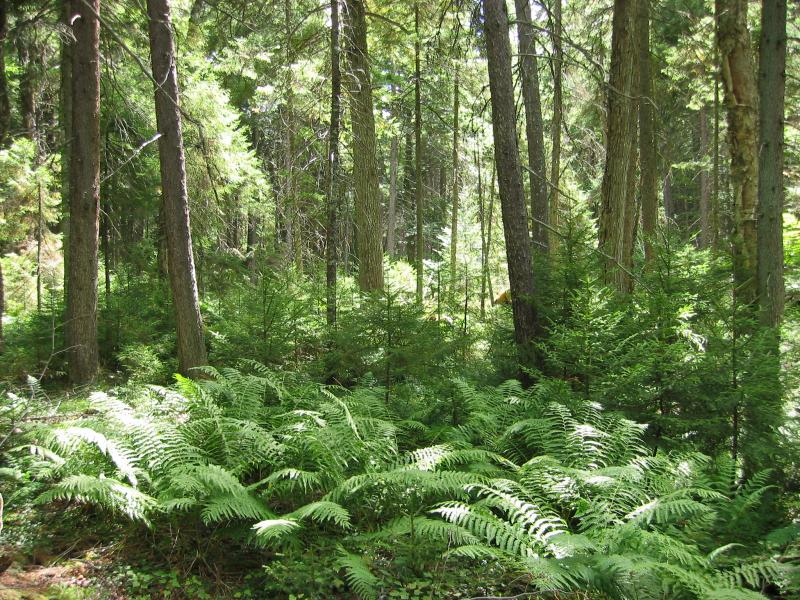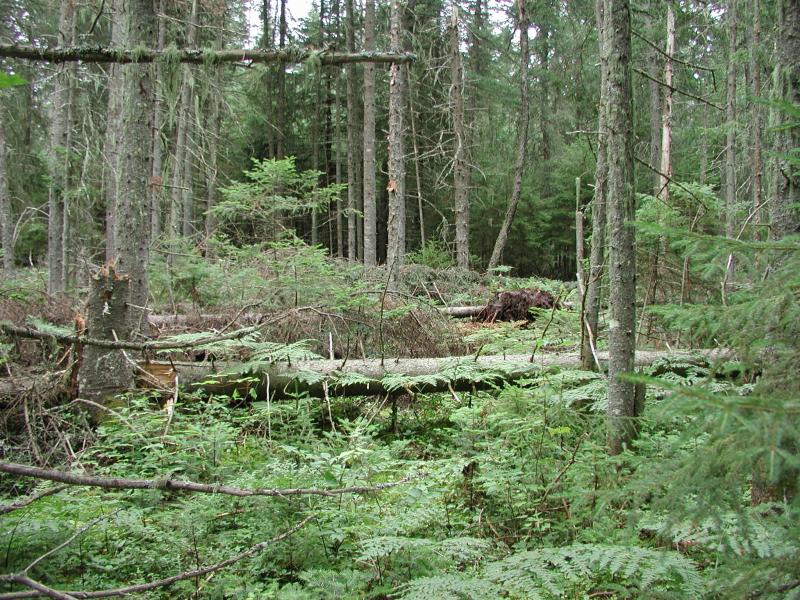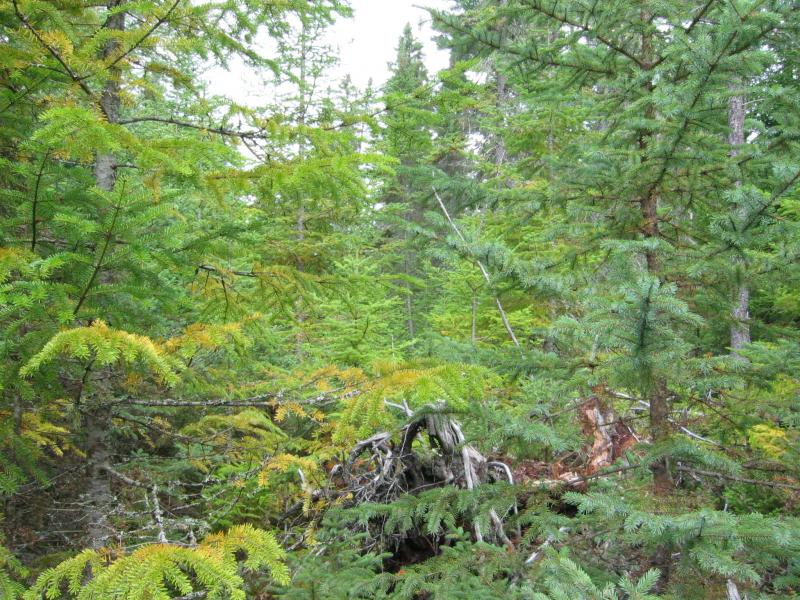Spruce Flats
- System
- Terrestrial
- Subsystem
- Forested Uplands
- State Protection
- Not Listed
Not listed or protected by New York State.
- Federal Protection
- Not Listed
- State Conservation Status Rank
- S3?
Vulnerable in New York (most likely) - Conservation status is uncertain, but most likely vulnerable to disappearing from New York due to rarity or other factors (but not currently imperiled); typically 21 to 80 populations or locations in New York, few individuals, restricted range, few remaining acres (or miles of stream), and/or recent and widespread declines. More information is needed to assign a firm conservation status.
- Global Conservation Status Rank
- G4?
Apparently Secure globally (most likely) - Conservation status is uncertain, but most likely uncommon in the world but not rare; usually widespread, but may be rare in some parts of its range; possibly some cause for long-term concern due to declines or other factors. More information is needed to assign a firm conservation status.
Summary
Did you know?
Spruce resin from red and black spruce trees has been used to seal seams and waterproof birch bark canoes. This resin was also used as a gum by native peoples and later by early American settlers. Spruce gum was first manufactured 1845, making it the first commercial chewing gum in the United States. By 1890, it was replaced by chicle from the Latin American sapodilla tree. Today, most gum is produced with synthetic materials.
State Ranking Justification
There are several hundred occurrences statewide, but very few are currently documented by New York Natural Heritage. A few documented occurrences have good viability and a few are protected on public land or private conservation land. This community is limited to the northern portion of the state and is concentrated in the Central Adirondacks where there are several very large, high quality examples. The current trend of this community is probably stable for occurrences on public land and private conservation land, or declining slightly elsewhere due to moderate threats related to development pressure and logging.
Short-term Trends
The number and acreage of spruce flats in New York have probably remained stable at protected sites or declined slightly elsewhere in recent decades as a result of logging, agriculture, and development.
Long-term Trends
The number and acreage of spruce flats in New York have probably declined substantially from historical numbers likely correlated with past logging, agriculture, and development.
Conservation and Management
Threats
Threats to forests in general include changes in land use (e.g., clearing for development), forest fragmentation (e.g., roads), and invasive species (e.g., insects, diseases, and plants). Other threats may include over-browsing by deer, fire suppression, and air pollution (e.g., ozone and acidic deposition). When occurring as expansive forests, the largest threat to the integrity of spruce flats are activities that fragment the forest into smaller pieces. These activities, such as road building and other development, restrict the movement of species and seeds throughout the entire forest, an effect that often results in loss of those species that require larger blocks of habitat (e.g., black bear, bobcat, certain birds). Additionally, fragmented forests provide decreased benefits to neighboring societies from services these societies often substantially depend on (e.g., clean water, mitigation of floods and droughts, pollination in agricultural fields, and pest control) (Daily et al. 1997). Spruce flats are threatened by development (e.g., residential), either directly within the community or in the surrounding landscape. Other threats include habitat alteration (e.g., roads, excessive logging, mining, flooding of adjacent waterbodies), and recreational overuse (e.g., ATVs, snowmobiles, hiking trails, campgrounds). A few spruce flats are threatened by invasive species from adjacent developed areas. Intentionally planted pine species may become established and become a minor threat to a few examples. Spruce flats may be threatened by acid rain deposition, but perhaps less than other higher elevation natural communities (US EPA 2005). Spruce budworm may be considered a threat to occurrences of spruce flats that experience extreme outbreaks, especially if it coincides with other stresses and reduces tree regeneration. The spruce budworm (Choristoneura fumiferana) is a native insect that creates canopy gaps in spruce and fir forests of the Eastern United States and Canada. Since 1909, there have been waves of budworm outbreaks throughout the eastern United States and Canada. The states most often affected are Maine, New Hampshire, New York, Michigan, Minnesota, and Wisconsin (Kucera and Orr 1981). Balsam fir is the primary host tree for budworm in the Eastern United States, although white, red, and black spruce are known to be suitable host trees. Spruce budworm may also feed on tamarack, pine, and hemlock. Spruce mixed with balsam fir is more likely to show signs of budworm infestation than spruce in pure stands (Kucera and Orr 1981).
Conservation Strategies and Management Practices
Management should focus on activities that help maintain regeneration of the species associated with this community. Although it is not currently a threat to spruce flats, deer have been shown to have negative effects on forest understories (Miller et al. 1992, Augustine & French 1998, Knight 2003) and management efforts should strive to ensure that regenerating trees and shrubs are not so heavily browsed that they cannot replace overstory trees. Avoid cutting old-growth examples and encourage selective logging areas that are under active forestry.
Development and Mitigation Considerations
Strive to minimize fragmentation of large forest blocks by focusing development on forest edges, minimizing the width of roads and road corridors extending into forests, and designing cluster developments that minimize the spatial extent of the development. Development projects with the least impact on large forests and all the plants and animals living within these forests are those developments built on brownfields or other previously developed land. These projects have the added benefit of matching sustainable development practices (for example, see: The President's Council on Sustainable Development 1999 final report, US Green Building Council's Leadership in Energy and Environmental Design certification process at http://www.usgbc.org/).
Inventory Needs
Inventory any remaining large and/or old-growth examples across the state. Continue searching for large sites in good condition (A- to AB-ranked).
Research Needs
Research the composition and collect sufficient plot data for spruce flats statewide in order to characterize variations and clearly separate this community from balsam flats, spruce-fir swamp, and spruce-northern hardwood forests. Regularly assess the presence and degree of impact that spruce budworm has on this community.
Rare Species
Range
New York State Distribution
This community is limited to the northern portion of the state. It is concentrated in the Adirondack Mountains where it is represented by large patch to near matrix size examples. It is probably also along the Saint Lawrence and Lake Champlain Lowlands. It is peripheral in the state on the Rensselaer Plateau and Tug Hill.
Global Distribution
This community is limited to the northern fringe of the Eastern United States and much of southeastern Canada. This range is estimated to span north to central Ontario and Quebec, west to Minnesota, south to northern Michigan and northern New York, and east to Nova Scotia and Newfoundland.
Best Places to See
- Adirondack Park
- Capital District Wildlife Management Area (Rensselaer County)
- Moose River Wild Forest, Adirondack Park (Hamilton County)
Identification Comments
General Description
A mixed forest that occurs along the borders of swamps and in low flats along lakes and streams in the Adirondacks, often in a tight mosaic with balsam flats. Soils are strongly podzolized, loamy to sandy, and seasonally moist, but not saturated or peaty. The canopy is usually dominated by red spruce (Picea rubens) and red maple (Acer rubrum), mixed with a variety of possible associates. Heath species dominate the shrub layer, and the forest floor is a carpet of bryophytes and herbs.
Characters Most Useful for Identification
Spruce flats have a canopy dominated by red spruce (Picea rubens) and red maple (Acer rubrum), with possible associates yellow birch (Betula alleghaniensis), black cherry (Prunus serotina), and eastern hemlock (Tsuga canadensis). The shrub layer is sparse and made up of heath species such as sheep laurel (Kalmia angustifolia) and blueberries (Vaccinium angustifolium, V. myrtilloides). The forest floor is covered with a dense carpet of bryophytes, such as Pleurozium schreberi, Hylocomium splendens, and Bazzania trilobata, and herbs such as bunchberry (Cornus canadensis), snowberry (Gaultheria hispidula), and goldthread (Coptis trifolia). A less common variant of this community is codominated by black spruce (Picea mariana) and tamarack (Larix laricina).
Elevation Range
Known examples of this community have been found at elevations between 1,380 feet and 2,589 feet.
Best Time to See
Many of the canopy species of this community are best recognized during the growing season (May to September); the luxurious carpet of mosses can be observed much of the year when snow is absent.
Spruce Flats Images
Classification
International Vegetation Classification Associations
This New York natural community encompasses all or part of the concept of the following International Vegetation Classification (IVC) natural community associations. These are often described at finer resolution than New York's natural communities. The IVC is developed and maintained by NatureServe.
- Black Spruce - Red Spruce / Schreber's Big Red-stem Moss Forest (CEGL006361)
- Red Spruce - Balsam Fir - Paper Birch Forest (CEGL006273)
- Red Spruce - Balsam Fir - Birch species - Red Maple Forest (CEGL006505)
NatureServe Ecological Systems
This New York natural community falls into the following ecological system(s). Ecological systems are often described at a coarser resolution than New York's natural communities and tend to represent clusters of associations found in similar environments. The ecological systems project is developed and maintained by NatureServe.
- Acadian-Appalachian Montane Spruce-Fir Forest (CES201.566)
- Acadian Low-Elevation Spruce-Fir-Hardwood Forest (CES201.565)
- Acadian Sub-boreal Spruce Flat (CES201.562)
Characteristic Species
-
Trees > 5m
- Abies balsamea (balsam fir)
- Acer rubrum var. rubrum (common red maple)
- Betula alleghaniensis (yellow birch)
- Larix laricina (tamarack)
- Picea mariana (black spruce)
- Picea rubens (red spruce)
- Pinus strobus (white pine)
-
Shrubs 2 - 5m
- Fagus grandifolia (American beech)
-
Shrubs < 2m
- Kalmia angustifolia var. angustifolia (sheep laurel, sheep-kill)
- Vaccinium myrtilloides (velvet-leaved blueberry)
- Viburnum lantanoides (hobblebush)
-
Herbs
- Clintonia borealis (blue bead-lily)
- Coptis trifolia (gold-thread)
- Cornus canadensis (bunchberry)
- Dryopteris carthusiana (spinulose wood fern)
- Osmunda claytoniana (interrupted fern)
- Osmundastrum cinnamomeum var. cinnamomeum (cinnamon fern)
- Oxalis montana (northern wood sorrel)
- Pteridium aquilinum ssp. latiusculum (eastern bracken fern)
-
Nonvascular plants
- Bazzania trilobata
- Dicranum scoparium
- Pleurozium schreberi
- Polytrichum commune
- Sphagnum girgensohnii
Similar Ecological Communities
- Balsam flats
(guide)
Balsam flats are similar to spruce flats in environmental setting and vegetation structure and often occur with them in a tight mosaic, but are dominated by balsam fir, with possible associates red spruce, black spruce, and hardwood species.
- Spruce-fir swamp
(guide)
Spruce-fir swamps are palustrine communities that occur within a basin or are associated with a pond or stream. The canopy is dominated by spruces (Picea spp.), balsam fir (Abies balsamea), and red maple. Unlike spruce flats, the shrub layer of spruce-fir swamps has characteristic wetland species such as mountain holly (Nemopanthus mucronatus), wild raisin (Viburnum nudum var. cassinoides), and winterberry (Ilex verticillata).
- Spruce-northern hardwood forest
(guide)
Spruce-northern hardwood forests are located at higher elevations and are typically drier than spruce flats. Characteristic woody species include red spruce, red maple, yellow birch, American beech (Fagus americana), striped maple (Acer pensylvanicum), mountain maple (Acer spicatum), mountain ash (Sorbus americana), and Canada yew (Taxus canadensis). Also, the forest foor does not have the extensive carpet of mosses that is characteristic of spruce flats, and it has a larger variety of herbaceous plants.
Vegetation
Percent cover
This figure helps visualize the structure and "look" or "feel" of a typical Spruce Flats. Each bar represents the amount of "coverage" for all the species growing at that height. Because layers overlap (shrubs may grow under trees, for example), the shaded regions can add up to more than 100%.
Additional Resources
References
Augustine, A.J. and L.E. French. 1998. Effects of white-tailed deer on populations of an understory forb in fragmented deciduous forests. Conservation Biology 12:995-1004.
Braun, E. Lucy. 1950. Deciduous forests of Eastern North America. Macmillan Publ. Co. Inc., New York, N.Y.
Daily, G.C., S. Alexander, P.R. Ehrlich, L. Goulder, J. Lubchenco, P. Matson, H.A. Mooney, S. Postel, S.H. Schneider, D. Tilman, and G.M. Woodwell. 1997. Ecosystem Services: benefits supplied to human societies by natural ecosystems. Issues In Ecology 2:1-16.
Edinger, G. J., D. J. Evans, S. Gebauer, T. G. Howard, D. M. Hunt, and A. M. Olivero (editors). 2014. Ecological Communities of New York State. Second Edition. A revised and expanded edition of Carol Reschke’s Ecological Communities of New York State. New York Natural Heritage Program, New York State Department of Environmental Conservation, Albany, NY. https://www.nynhp.org/ecological-communities/
Edinger, Gregory J., D.J. Evans, Shane Gebauer, Timothy G. Howard, David M. Hunt, and Adele M. Olivero (editors). 2002. Ecological Communities of New York State. Second Edition. A revised and expanded edition of Carol Reschke's Ecological Communities of New York State. (Draft for review). New York Natural Heritage Program, New York State Department of Environmental Conservation. Albany, NY. 136 pp.
Eyre, F.H., ed. 1980. Forest cover types of the United States and Canada. Society of American Foresters, Washington, D.C.
Heimburger, C.C. 1934. Forest-type studies in the Adirondack Region. Cornell University Experiment Station Memoir 165, Ithaca, New York.
Knight, T.M. 2003. Effects of herbivory and its timing across populations of Trillium grandiflorum (Liliaceae). American Journal of Botany 90:1207-1214.
Kucera, D.R. and P.W. Orr. 1981. Spruce budworm in the eastern United States. Forest Insect and Disease Leaflet 160. U.S. Department of Agriculture, Forest Service, Washington, D.C.
McMartin, B. 1994. The Great Forest of the Adirondacks. North Country Books, Utica, NY. 240 pp.
Miller, S.G., S.P. Bratton, and J. Hadidian. 1992. Impacts of white-tailed deer on endangered and threatened vascular plants. Natural Areas Journal 12:67-74.
New York Natural Heritage Program. 2024. New York Natural Heritage Program Databases. Albany, NY.
Reschke, Carol. 1990. Ecological communities of New York State. New York Natural Heritage Program, New York State Department of Environmental Conservation. Latham, NY. 96 pp. plus xi.
United States Envoronmental Protection Agency. 2005. Effects of Acid Rain: Forests. Available on line at http:www.epa.gov/airmarkets/acidrain/effects/forests.html Accessed March 2, 2005.
Links
About This Guide
This guide was authored by: Jennifer Garrett
Information for this guide was last updated on: November 13, 2023
Please cite this page as:
New York Natural Heritage Program. 2024.
Online Conservation Guide for
Spruce flats.
Available from: https://guides.nynhp.org/spruce-flats/.
Accessed July 27, 2024.



